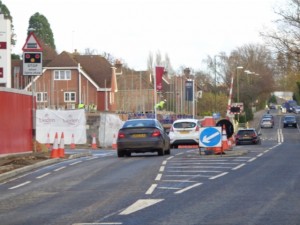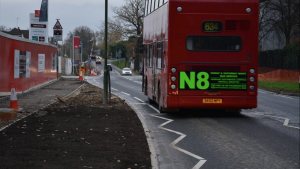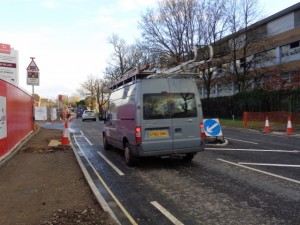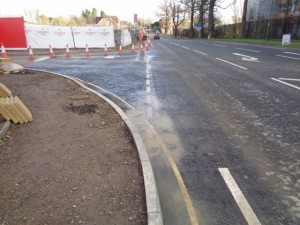Essential safety improvements promised as part of the development of the former Novartis site on Parsonage Road have not been delivered.
The provision of 1.5m cycle lanes was a key part of the developer’s proposal to mitigate the effects of the additional traffic generated by 160 new homes and the widening of the road to allow a right-turn filter lane to the site on Parsonage Road.
In place of the promised 1.5m lanes, very narrow 70cm lanes have been repainted on the road. These lanes do not meet the recommended minimum width of 1.5m and are dangerous for cyclists.
UPDATE 19/12/2015: We organised a brief protest which was reported in the West Sussex County Times.
New junction
The existing 70cm “cycle lanes” were also far from ideal, but because Parsonage Road is wide and straight motorists could overtake cyclists by giving them a wide berth (usually involving crossing over the centre line to pass).
The design of the new junction however means that cyclists will now need to be fully within the 70cm lanes to allow vehicles to pass (the right-turn filter lane and the traffic island near the junction prevent motorists from crossing the centre line).
However, since it is not possible to keep a safe distance from the kerb and fit within 70cm, people riding bikes will always be outside the lane yet motorists will not be expecting cyclists to be there.
Travelling west along Parsonage Road
Going west towards North Heath Lane, cars are squeezed into their “lanes” (whether going straight on or using the right-turn filter lane) with no room to manoeuvre around any cyclists.
Motorists will expect cyclists to be fully within the 70cm lanes (despite the fact that the lanes are too narrow to fully accommodate a cyclist). In fact they will need cyclists to be fully within the 70cm lane so that they can negotiate the junction at undiminished speed.
Travelling east along Parsonage Road
Going east towards the level crossing, the situation is similar. The first danger for cyclists is the pinch point approaching the junction.
Cars are then squeezed by the traffic island into their “lane” with no room to overtake any cyclists. Motorists’ attention will be focused on negotiating the junction (and looking out for pedestrians on the island).
Any cyclists (who will not be within the 70cm lane) will not be so easily spotted and will be placed in danger because there is no space to overtake and motorists will need to suddenly slow down. Aggressive and impatient drivers will simply try to squeeze through the gap.
The greatest danger for cyclists however is probably that of being left-hooked as they cross the entrance to the development. Cars are given a wide splay at the side entrance that encourages them to maintain speed as they turn left and cyclists do not have priority across the junction.
Background
In WSCC’s Strategic Planning Consultation for the development it was noted that Parsonage Road is a “designated cycle route” with advisory cycle lanes and that the developers “propose widening these to 1.5m to comply with current guidance within the existing wide carriageway width of Parsonage Road”.
In HDC’s Development Management Committee Report to Councillors, West Sussex Highways requested “better advisory cycle lanes”.
North Horsham Parish Council in their letter of representation to the Committee stated that “the proposed development would have an adverse impact upon the needs of cyclists in the area”.
The Stage 1 Safety Audit identified “inconsistent cycle facilities“ and the summary report (produced by the transport consultants appointed by the developers) stated that “the omission of the on-road cycle facilities could place cyclists at increased risk from collision with passing traffic”.
In the cycle forum’s comments on the original planning application we stressed the need for significant improvements to the cycling infrastructure on the surrounding road network to mitigate the effects of the additional traffic generated by this development (and other forthcoming developments).
We drew attention to the need to make cycling a safe, attractive and practical alternative to car use for the residents, resulting in reduced congestion and pollution for everyone and providing economic benefits since cyclists will use local shops and businesses.
The National Planning Policy Framework (the overarching planning guidance document) states that:
“The transport system needs to be balanced in favour of sustainable transport modes, giving people a real choice about how they travel.”
“[Developments should] give priority to pedestrian and cycle movements.”
This was backed up by local policy (CP19 of Horsham District Council’s Core Strategy):
“[The Core Strategy favours] a rebalancing in favour of non-car modes as a means of access to services and facilities.”
“[Priority will be given to schemes that] enhance the facilities for pedestrians, including those with reduced mobility, and other users such as equestrians and cyclists.”
As well as by Government guidance:
“[The Department of Transport] expects local authorities to up their game in delivering infrastructure that takes cycling into account from the design stage.”
The cycle lanes in Parsonage Road are extremely narrow, and are well below the recommended minimum in LTN2/08 – in fact they are narrower than the recommended riding position away from the kerb in Bikeability training!
You can read our full comments here.
Possible solutions
Remove or reduce the right-turn filter lane and reduce the splay on the entrance to the site. Is a filter lane on a turning to a cul-de-sac off an unclassified residential road really necessary?
These measures would reduce the risks from drivers turning into the site at high speed and provide space for the 1.5m cycle lanes on both sides of the road, so that it would be safe for cyclists to cross the site entrance.
North Horsham Parish Councillor Karen Burgess told us:
“I was astounded to see how narrow these cycle lanes were. I would certainly not be keen to use them.”
“These are in my view more dangerous than no lanes at all, particularly as children on their way to Forest and Millais will almost certainly be using them.”
The road design encourages inappropriately fast traffic and places cyclists in a dangerous position. We have written to Paul Addison, Head of Strategic Planning at WSCC, asking for the new markings to be removed and replaced by the planned 1.5m lanes.
A selection of tweets:
@AsEasyAsRiding A 70cm wide cycle lane? What the **** were they thinking ?
— Simon (@SimonWickers) December 2, 2015
https://twitter.com/seanlondonandon/status/672171314493325313
.@WSCCNews Correction: cyclists are expressing *disgust* at Horsham's new cycle lanes https://t.co/s9bdrVAo1m
— Horsham District Cycling Forum (@CycleForumHorsh) December 3, 2015
@HerbieGreen @CycleForumHorsh @WSCCNews That's actually narrower than my handlebars
— Kai (@4catsnomore) December 3, 2015
Freshly painted cycle lane on newly-built, widened road. 70cm wide. pic.twitter.com/aHddnKmADP
— Mark Treasure (@AsEasyAsRiding) December 2, 2015





As usual nothing will be done until some poor cyclist is knocked down and badly injured. I just hope it is not me as I use this road a lot. I have often ridden on the pavement when the road is busy. I actually wondered why the road was.nt widened as there was such a wide grass verge on the factory side. Also ,why were the houses built so close to the road when such a large site was available? More money for the developer I suppose. How was the infrastructure money used? If we received any that is.